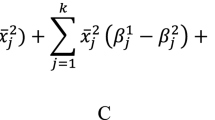Abstract
The OECD Family database has been developed to collate in one central location information and indicators relating to family outcomes, family policies and children in order to address the growing demand for cross-national information on the situation of families and children. The information is taken from different OECD databases, specifically developed questionnaires and non-OECD sources. The OECD Family database now includes 52 indicators across four broad headings: the structure of families, families and children, the labour market position of families, public policies for families and children, and child outcomes. This paper presents the Family database and discusses data and methodological issues as illustrated by selected example indicators.














Similar content being viewed by others
Notes
Using the 15–49 age group to calculate total fertility rates is not entirely correct as in many countries there has been an increase in the number of women giving birth in their 50s. However, this number remains small so the resulting error is negligible.
The replacement value of 2.1 is also a rough estimate of the replacement of a population as infant mortality rates vary between countries; in countries where infant mortality is above average, replacement values would be correspondingly higher.
References
Adema, W., & Ladaique, M. (2009). An interpretative guide to gross and net social spending in the OECD Social Expenditure database (SOCX). Social, employment and migration working papers. OECD, Paris (www.oecd.org/els/workingpapers).
Adema, W., & Thévenon, O. (2008). Les politiques de conciliation du travail et de la vie familiale en France au regard des autres pays de l’OCDE. Recherches et Prévisions, 933, 51–72.
D’Addio, A.-C, & Mira d’Ercole, M. (2005). Trends and determinants of fertility rates in OECD countries: The role of policies. OECD social, employment and migration working papers, no. 27. OECD, Paris (www.oecd.org/els/workingpapers).
Immervoll, H., & Barber, D. (2005). Can parents afford to work? Childcare costs, tax-benefit policies and work incentives. Social, employment and migration working papers, no. 31. OECD, Paris (www.oecd.org/els/workingpapers).
IOTF. (2006). International Obesity TaskForce, http://www.iotf.org/childhood/euappendix.htm.
ILO (2006). Labour Statistics Database: SEGREGAT, Employment by sex and detailed occupational groups: 1970–2000 (http://laborsta.ilo.org).
Lohmann H., Peter, F. H., Rostgaard, T., & Spiess, C. K. (2009). Towards a framework for assessing family policies in the EU. OECD social, employment and migration working papers. No. 88, (www.oecd.org/els/workingpapers).
MISSOC. (2007). Mutual information system on social protection in the EU and EEA, http://ec.europa.eu/employment_social/social_protection/missoc_tables_en.htm.
NOSOCO. (2007). Social protection in the Nordic countries. Copenhagen: Nordic Social Statistical Committee.
Moss, P., & Korintus, M. (2008), International review of leave policies and related research 2006. DTI employment relations research series, No. 100. Department of Trade and Industry.
OECD. (2001). Starting strong. Paris: OECD.
OECD. (2002). Babies and Bosses: Reconciling work and family life, vol. 1, Australia, Denmark, the Netherlands. Paris: OECD.
OECD. (2003a). Babies and Bosses: Reconciling work and family life, vol. 2, Austria, Japan and Ireland. Paris: OECD.
OECD. (2003b). Taxing wages 2001–2002—special feature: Taxing families. Paris: OECD.
OECD. (2004). Babies and Bosses: Reconciling work and family life, vol. 3, New Zealand, Portugal, Switzerland. Paris: OECD.
OECD. (2005). Babies and Bosses: Reconciling work and family life, vol. 4, Canada, Finland, Sweden, and the United Kingdom. Paris: OECD.
OECD. (2006). Starting strong II. Paris: OECD.
OECD. (2007a). Babies and Bosses. Paris: OECD.
OECD. (2007b). Benefits and wages. Paris: OECD.
OECD. (2007c). PISA 2006 science competencies for tomorrow’s world. Paris: OECD.
OECD. (2008a). Labour force statistics, 1985–2005. Paris: OECD.
OECD. (2008b). Education at glance. Paris: OECD.
OECD. (2008c). OECD social expenditure database, 1980–2003. Paris: OECD.
OECD. (2008d). Employment outlook. Paris: OECD.
OECD. (2009a). Society at glance. Paris: OECD.
OECD. (2009b). Doing Better for Children. Paris: OECD.
Sleebos, J. (2003). Low fertility rates in OECD countries: Facts and policy responses. OECD social, employment and migration working papers, no. 15. OECD, Paris (www.oecd.org/els/workingpapers).
Thévenon, O. (2008a). Family policies in OECD countries: Contrasted models. Population and societies, 448, Paris, http://www.ined.fr/en/resources_documentation/publications/pop_soc/.
Thévenon, O. (2008b). Family policies in Europe: Available databases and initial comparisons. Vienna Yearbook of Population Research: 165–177, http://www.oeaw.ac.at/vid/publications/VYPR2008/VYPR2008.shtml.
United Nations Children’s Fund/World Health Organization. (2004). Low Birthweight - Vountry, Regional and global estimates, Unicef, New York.
Whiteford, P., & Adema, W. (2007). Combating child poverty in OECD countries: Is work the answer?. Social, employment and migration working papers, no. 51. OECD, Paris (www.oecd.org/els/workingpapers).
Author information
Authors and Affiliations
Corresponding author
Additional information
The authors have all contributed to the development of the OECD Family database, as they worked in the Social Policy Division of the OECD Directorate of Employment, Labour and Social Affairs. The views expressed in this paper cannot be attributed to the OECD or its Member Countries: as with any remaining errors, they are the responsibility of the authors alone.
Appendix
Appendix
Rights and permissions
About this article
Cite this article
Adema, W., del Carmen Huerta, M., Panzera, A. et al. The OECD Family Database: Developing a Cross-National Tool for Assessing Family Policies and Outcomes. Child Ind Res 2, 437–460 (2009). https://doi.org/10.1007/s12187-009-9044-8
Accepted:
Published:
Issue Date:
DOI: https://doi.org/10.1007/s12187-009-9044-8




